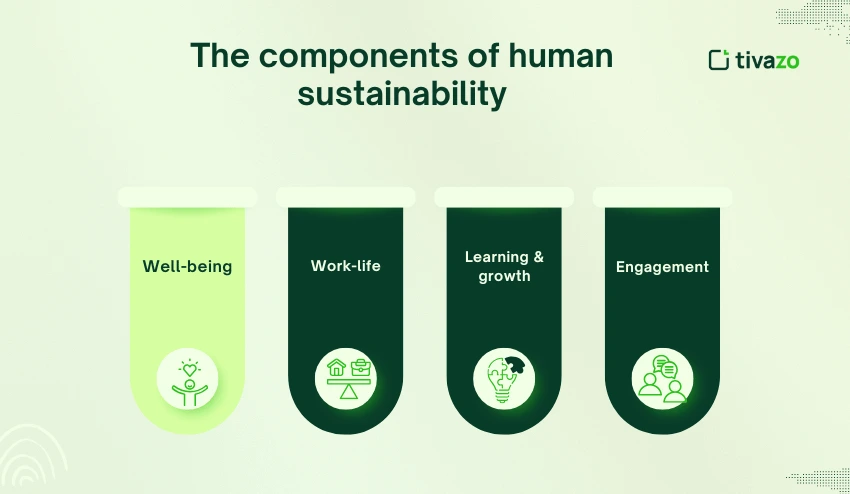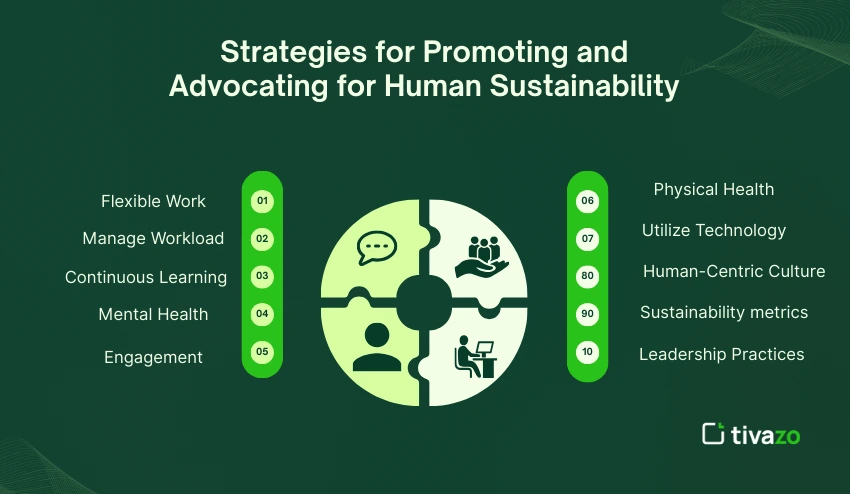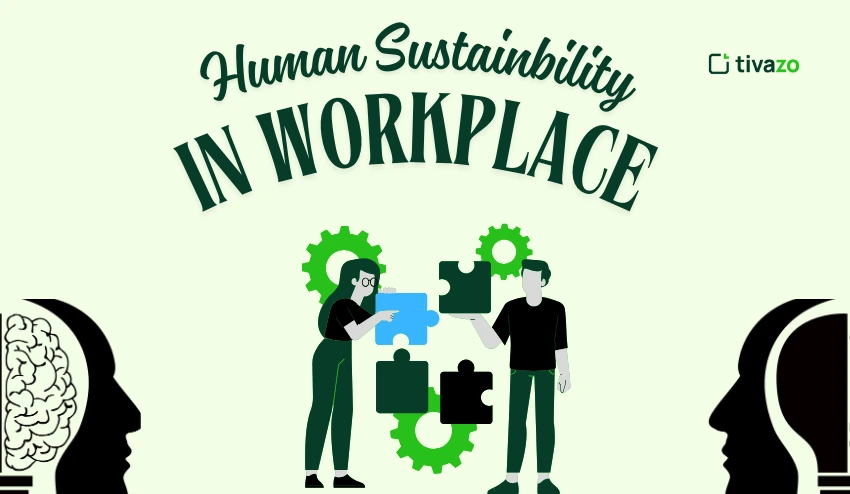Human sustainability refers to the creation of a workplace that allows people to flourish in the long term. It originates from concerns around employee wellbeing, productivity, and engagement, and the idea of enabling individuals and organizations to prosper sustainably.
According to Ninomiya, human sustainability is a necessity in today’s work environment. As the battle for talent heats up and organizations change at a rapid pace, embracing all aspects of human sustainability is something organizations will not be able to overlook. Organizations that commit to human sustainability will benefit from either extended bottom-line impact, reduced turnover or staff disruption, and enhanced workplace culture. Commitment to human sustainability will also help individuals build resilience amid change, encourage innovation, and promote a sense of purpose that contributes to teams that are ultimately willing to adapt and stay motivated for the long haul.
Key Highlights:
- What is Human Sustainability?
- Why Does Human Sustainability Matter?
- Human Sustainability Examples
- How to Promote and Prioritize Human Sustainability
- Enhancing Employee Experience
- Metrics to Monitor
- Additional Sustainable Practices
- How Tivazo Helps Human Sustainability
What does Human Sustainability involve?
Human sustainability is the process for protecting and improving employee health and health-related productivity over time, versus expectations of solely improving on any one aspect and not the others. It broadly focuses on human success over the long term and the sustained capacity of a health organization. By prioritizing human sustainability, organizations will, at a minimum, provide work environments that allow employees to feel that they can perform their jobs at a high level while staying physically, mentally, or emotionally healthy.
Promoting human sustainability gives all employees what they need to be successful in their work, and the organization benefits from being able to provide more employee performance, lower the leaving rate of employees, and develop both an engaged and healthy work culture.
The components of human sustainability
- Well-being: The organization should provide physical health, mental health, emotional health support, and a foundation to build on-whether that be wellness support programs, counselling opportunities, and stress management programs.
- Work-life: Flexible hours to accommodate work, manageable workloads or shifting expectations, policies, practices, and tracking performance that allow for managing work commitments with personal commitments.
- Learning and growth: Essentially, the opportunities the employee has for continued next-level professional development-training, mentorship, certifications, career progression opportunities, etc.
- Engagement: Recognition, continuous feedback, developing a culture that is warm, welcoming, inclusive, fosters ideas together, and important that all employees feel a purpose in any work they do.
Measure and manage one or more of those components in your workplace practices and culture. Contributor to psychological/environmental safety in the workplace. Policies to help employees feel motivated, satisfied, and sustainably productive in the long run. Like many things, it is a holistic approach that strives to include employee well-being and to duly recognize the human work and support the success of the organization.

The significance of Human Sustainability
Human sustainability is key because employees are the most important asset of any organization. Without a focus on sustainability at work, organizations risk burnout, lower morale, and higher turnover rates. Investing in human sustainability means investing in healthy, engaged, and empowered employees to ensure long-term sustainability.
The benefits of human sustainability
| Benefit | Why is it important |
| Increase productivity | Healthy and motivated employees are more productive. |
| Reduced absenteeism | Well-being programs improve body biology, reducing stress and sick leave |
| Increase retention | Employees can stay at organizations longer when supported at work. |
| Positive culture | Encourages relationships, trust, collaboration, and engagement |
Sustainable organizations are better situated to attract quality employees, respond to shifts in the market, and stimulate innovation. A healthy, motivated workforce provides new ideas, innovative thinking, problem-solving ability, and stability, all of which contribute to profitability and competitive advantage. In short, organizations that practice sustainability increase human, financial, and ecological resources and create practices to protect their (and employees’) growth opportunities.
Organizations need to embed sustainability into their workplace practices to protect employees’ health and well-being, build their productivity, and protect their organization’s growth and resiliency in a volatile business landscape.

Examples of Human Sustainability
The following are just a few of the ways organizations can put human sustainability into practice:
1. Flexible Work Schedules
Allow employees to manage their work-life balance by adjusting schedules based on their immediate needs.
2. Mental Health Resources
Counseling, stress management, and wellness programs to provided to support employees’ emotional health.
3. Ergonomic Workstations
Trains reduce strain on physical health by providing appropriate furniture to use, lighting to use, and configurations that enhance posture.
4. Continual Education
Training programs, mentorship, and/or development programs to enable employees to continue to make their skills relevant, and keep their career on another trajectory.
5. Celebrating Employee Performance
Recognizing accomplishments and milestones to drive motivation and morale.
6. Employee Options to work remotely
Supporting organizational readiness and giving employees control, flexibility, and a sense of casualness to reduce stress from commute and rigidity.
7. An Inclusive Culture
Promoting diversity, belonging, and psychological safety gives employees a sense of comfort and competence.
Other examples may include wellness challenges, collaboration/team building, career coaching, and mentoring programs. Some organizations will also engage in employee feedback opportunities so they can learn what the organization can improve upon. Any or all of these examples support an authentic commitment to human sustainability. They help employees feel valued, supported, engaged, and motivated in the long run, while aligning the organization’s limits on time to employee health and wellness.

Strategies for Promoting and Advocating for Human Sustainability
Flexible Work
Allow employees flexibility to schedule their hours. Tivazo’s timekeeping will verify that employees will be productive without overworking them.
Manage Workload and Avoid Burnout
Tivazo will provide information by way of data to see patterns and share compliance work correctly so your people and organization don’t suffer from work-related stress, fatigue, exhaustion, and other elements that negatively impact our health and well-being.
Continuous Learning
Support and provide training, certifications, or any type of mentorship programs. Employees add valuable skills to their repertoire, while organizations will benefit from improved capability.
Mental Health
Encourage breaks and wellness activities and foster open conversations about stress management and related issues.
Engagement
Use regular feedback, recognition, and team-related activities to instill motivation within the workplace.
Physical Health
Provide and/or pay for ergonomic furniture, opportunities for healthy activities, and even check-ups, to help combat physical health injuries and strains.
Utilize Technology to Inform Decisions
Use Tivazo’s analytics to help dissect behaviour patterns over periods of time and to help identify trends and factors pertaining to employee-work productivity, workload, and employee engagement to explain variations in collective productivity, engagement, etc, using data-driven decision-making.
Create a Human-Centric Culture
Encouraging teamwork and collaboration and making people feel like they belong and are included in the decision-making process, helps build trust and fosters psychological safety.
Measuring Human Sustainability metrics
Regularly quantifying how to humanely measure engagement, productivity, retention, and absenteeism. motivation, well-being, to discover trends so you can assess what you are doing to improve sustainable practices around human sustainability, etc.
Connecting to Leadership Practices
Train your managers about sustained work-related well-being. Help your managers acknowledge and celebrate the extraordinary contributions employees bring to the organization. Allow your managers to foster and accept inclusive environments for clarity-like communication. Leadership affects every aspect of the organizational plagiarism vis-à-vis human sustainability and other related issues.

Why Human Sustainability is Important
Human sustainability is important because employees are the most important asset in any company. Without a sustainable approach to support your employees, organizations risk burnout, low morale, and attrition. By taking a human sustainability approach, you are setting up your organization for future success by ensuring employees are healthy, engaged, and empowered to perform work at their best.
Human sustainability adds value to the work of your organization.
| Benefit | Why is it important |
| Increased productivity | Employees work better when they are healthy and motivated. |
| Lower absenteeism | Well-being programs decrease stress and sick leaves. |
| Higher retention | Employees with supportive environments stay longer. |
| Positive culture | Develops trust, collaboration, and engagement. |
Moreover, organizations focused on human sustainability will find it easier to attract top talent, will be better equipped to adjust to market changes, and will experience increased innovation activity. A healthy and motivated workforce also brings diverse ideas, problem-solving components, and stability that are very much a part of sustainable growth and profitability. The sustainable methods of your organization not only support your people, they also support your organization, its growth, and health within a changing business environment.
Metrics to Monitor
- Organizations should monitor key metrics to maintain human sustainability:
- Employee engagement levels: Monitor levels of satisfaction and commitment.
- Retention and turnover statistics: Understand the financially impacted needed retention activities
- Burnout triggers: Catch stress levels early before they stack and negatively impact performance.
- Schedule reports (Tivazo): Watch for workloads and don’t work beyond limits.
These metrics will provide some usable information to gain a handle on sustainable operations and know when to pivot in regards to better practices, tools, or processes to manage your workforce.
Additional Sustainable Practices
Sustainable businesses continually seek to systematically implement practices that include:
- Periodic check-ins and feedback opportunities, maintain connection with your employees, remain supportive, and keep lines of communication open for any issues of concern to be addressed early.
- Wellbeing programs that are part of the routine, support breaks, support physical exercise, and support mental mindfulness processes for mental focus and energy.
- Monitor and insights through technology-based solutions, e.g., Tivazo, that track time spent, productivity, engagement, etc., to help organizations capitalize on data.
- Support a culture of lifelong learning; training, mentoring, and development opportunities are ongoing. Ultimately, accountability for supporting success.
- Continual recognition and rewards: Recognize success on an ongoing basis to sustain motivation, productivity, and engagement.
- Cross-team work: Foster cross-team communication and work.
- Policy reviews and updates: Regularly and consistently review and update workplace policies as needed to address employees’ evolving needs fairly and equitably.
If organizations embrace these practices with good leadership and good organizational culture, they will be able to enable long-term human sustainability where employees will thrive, engage, and perform.
How Tivazo Helps Human Sustainability
Tivazo helps organizations put human sustainability in place efficiently:
- Time Tracking: Ensures employees work optimal hours and do not make them way too busy.
- Employee Monitoring: Helps detect workload gaps to know if an employee is burning out.
- Analytics & Reports: Gives perspective so employee workflows, engagement, and sustainability strategies are optimally positioned.
As organizations adopt Tivazo, they can feel good about having a healthy workforce that is motivated while maximizing productivity for the organization.
Conclusion
Human sustainability is more than just a workplace trend—it is a long-term strategy that ultimately impacts employee well-being, organizational performance, and the long-term health of the business. Focusing on employee health in terms of physical, mental, emotional, and continuous, and hence long-term growth, will result in a balanced presence in the workplace, increasing wellness, and creating a culture of belonging and inclusivity.
Practical considerations like flexible working schedules, wellness programs, ergonomically designed workspaces, and professional development not only improve individual productivity but also decrease employee turnover and absences. Technology has played a huge role in improving human sustainability as well. For example, Tivazo’s time tracking and employee monitoring tools help managers stay keyed into their team’s activities in real-time, which can make it easier to spot burnout as well as optimize workloads, bolstering a less stressful workplace.
Human sustainability can provide companies with a competitive edge over their rivals. By emphasizing human sustainability, companies position themselves to attract talent, build loyalty, and ultimately create environments that foster higher degrees of creativity and innovation. By aligning company goals with employee goals, companies become a win-win environment for people and performance. Sustainable workplaces are not built overnight, but building sustainable practices every day can provide all the foundation the company needs to create a sustainable place to work now and into the future.




